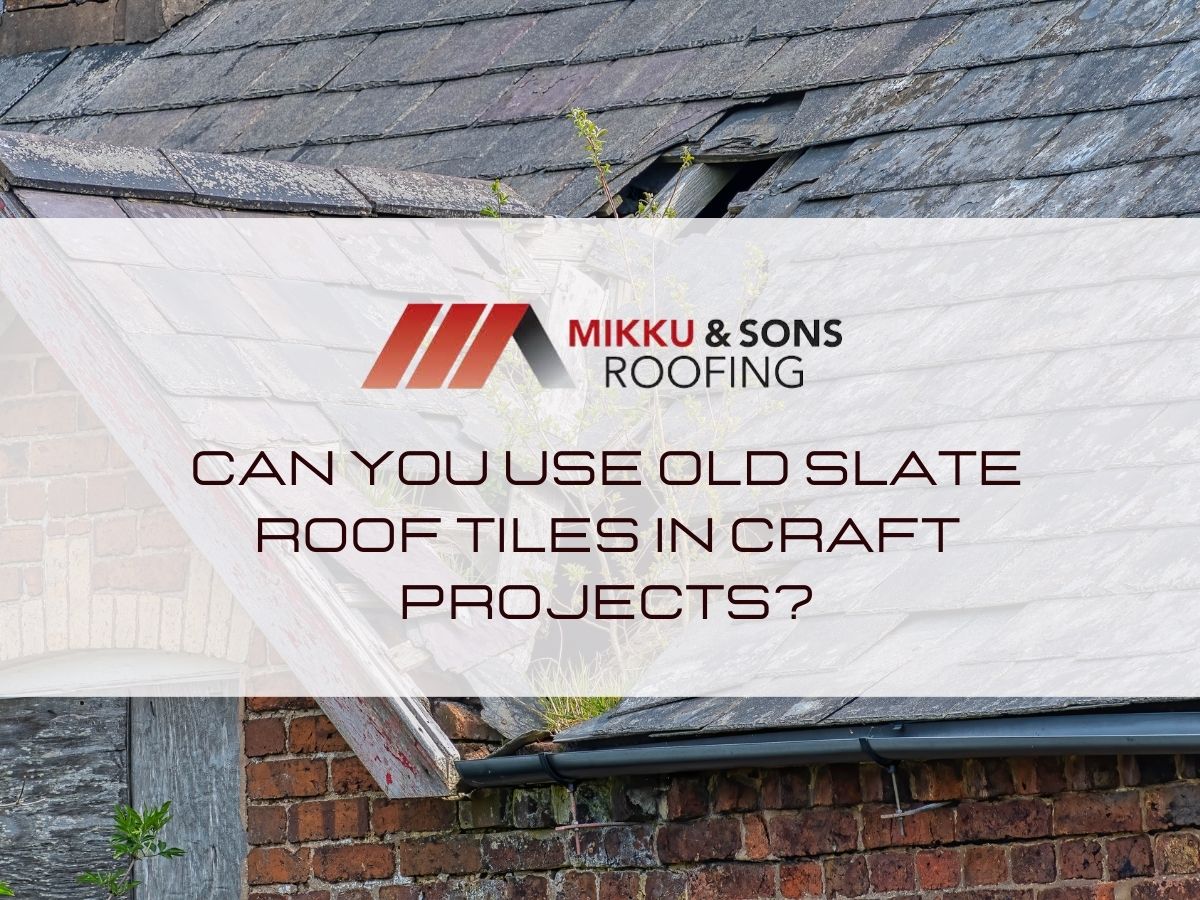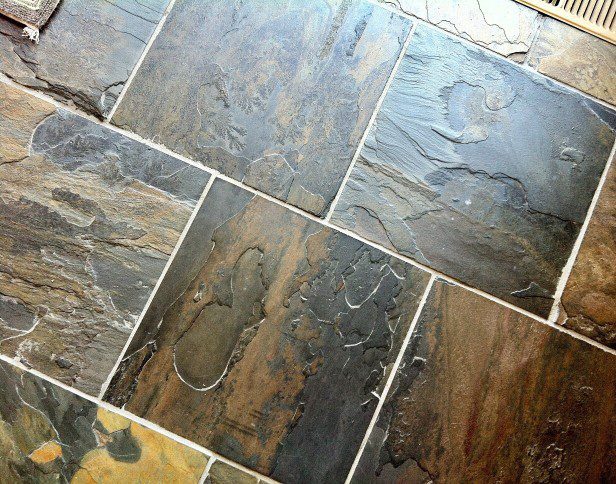

Slate is an enormously common material with a range of applications, most famously in roofing and flooring, where slate roof tiles are becoming increasingly popular.
But as time has gone by, our applications for slate have only grown more. From snooker tables to the basic domestic cheeseboard, slate is gaining popularity for increasingly more uses.
In today's world, we are becoming more mindful of our environmental effects, and we are starting to recycle and reuse everything feasible.
People are repurposing their usually worthless goods and damaged materials into fresh and revived pieces of utility and art, including slate roof tiles.
Here are some fascinating ideas that you may utilize if you have some old slate roof tiles.

Any material can be a canvas, as an artist or creative person knows, but slate allows you to go extra creative.
Slate may serve as a plethora of creative avenues if you allow your imagination to run wild. Creating a painting on a piece of slate is just one of the many ways you can use the material to decorate your home.
If you still have some leftover slate roof tiles leftover, here are some additional ideas for creative projects:
Make a rustic, oblong candle holder out of four pieces of slate, then sit back and enjoy with a few tealights.
This is a great way to prevent water from seeping out of your pots, such as a planter or a terrarium.
However, you may use a slate panel as a drain or gutter cover. You can prevent your drains from being blocked up with leaves and other debris, particularly in the fall.
It can also operate as a divider for herbs in the garden. Using slate to divide your herbs in a garden bed will ensure that they get all the water and nutrients they need while also keeping everything in order.
Typically, slate roof tiles are of dark color and store heat from the sun throughout the day and then return it to the plants at night.
Make a walkway, drive, or a separate section of your garden out of your leftover slate by recycling it into smaller pieces.
You can use this material to construct whatever you want in your garden, from an additional seat and planting area to an area suited for a water feature.
You could even leave your slates bigger and push them into the concrete yourself to have a distinct look. Ideas for repurposing outdoor materials include:
Pond liners are impermeable geomembranes used to retain liquids, such as reservoirs lining, retention basins, surface impoundments for hazardous and nonhazardous materials, and garden ponds and artificial streams in parks and gardens.
The pond liner is hidden by stone pond borders, giving the illusion of a natural pond in your yard.
The slate stone is an excellent choice for burying pond liners around the perimeter because it is hard and won't wash silt into the pond like softer stones like sandstone.
Slate is a flat stone, but it wobbles as you walk on it, so, if possible, use mortar to keep the stones secured.
Get rid of the wrinkles by laying each edge of your pond liner out evenly on the ground.
Both narrow and broad borders are available, allowing many rows of stones to be placed on the edge. Wait until the conclusion of the process to remove the surplus liner.
Using a 5′′ by 5′′ sheet of paper, the students begin by sketching their favorite California fruit. Next, they pull, connect, mold, and texture the one-dimensional design into a 3-dimensional tile.
This tactile art activity was a big hit with most youngsters, and they made gorgeous, realistic avocados, corn husks, bunches of grapes, cherries, artichokes, Meyer lemons, and navel oranges!
Our on-site kiln was used to heat the tiles after drying for around two weeks. Kids painted their tiles with underglaze and dipped them in the purple glaze after the first fire. The pupils were thrilled with the outcomes.
Simple floor tile mosaics may be made using slate tiles and a thin neutral grout line. Rather than purchasing just one color of the tile, use a variety of hues. Lay arrange your tiles in a mosaic before gluing them in place – and only then, when you're satisfied, cement them in place.
It is possible to get a slate floor tile in about any color or design that you like. Pure grey/black tiles are the most prevalent.
Those identical tiles may also be found with various color splashes, ranging from cream to brown to red and orange, ranging from little to significant splashes.
You may start with a base color (or color combination) and then add additional colors at random. Alternatively, you may be fully arbitrary, with no one hue taking center stage.
Speak with a professional tile installer about your mosaic tile design. Ensure that the quality, thickness, and size of all of your varied colored slate tiles are consistent.
There is nothing more demanding for Éco Dépôt's tile professionals than helping a customer create their own floor tile mosaic.
Mosaics are a fantastic way to express your individuality, and seeing the result is the icing on the cake.

The way you divide up your outdoor space is almost as crucial as what you put in it when designing it. Garden edging ideas might help with that.
Finding the perfect edging may make a difference in creating a clean garden. They not only enhance the visual aesthetic of your garden, but they also serve a useful purpose by separating flower beds from lawns and mulch from the latter.
It provides a crisp line to make mowing and trimming even more effective.
One neat idea is to use cap your pre-existing retaining walls bricks with old slate roof tiles. This can also be done on the bricks that edge your lawn. You just cut the slate tile to be even with the bricks and then use a mortar or stong adhesive to secure the slate. Use different colors to add more dimesion.
Jordan Woolf | Roofer in Madison Al
The ceiling of your tool shed may be covered with skates. Slating has been going on for hundreds of years.
As long as the conditions are right, this system will keep your roof safe from the elements. Slate roof tiles are becoming increasingly common due to the protection they provide, despite being inexpensive and requiring little time to make.
Slate roof tiles may be used in various ways, including recycling! If you don't plan to utilize your slates, give them away to someone who can benefit from their adaptability.
A local school, an artist, a handyperson, or a builder might benefit from the materials. There should be a variety of methods to ensure that the materials are put to good use.

Slate tile flooring is a popular option because of its natural beauty and durability.
While more effort and attention to detail are required to keep natural stone looking its best, it will survive for many years if you take the time to care for your slate tile floor properly.
Daily sweeping is recommended for slate flooring. There may be some "spalling" in the first few months following installation, in which tiny portions of the surface may flake off.
This is particularly true during this period. Once the slate tile has been firmly embedded, this should cease to be an issue.
Reclaimed slate tile flooring will alot of time outlast the other flooring options on the market such as vinyl or LVP flooring. Consider it free material if you are able to reuse the material!
Tyler Hull | Bubble Gum Flooring | Floor Installation Company in Milwaukee
Use a mild cleanser to clean the slate tile on your floor. Let it air dry, or use a soft towel to wipe it dry after rinsing with clean water. It's possible to clean natural stone using any other cleaning solution that doesn't include lemon or vinegar - ideally one that's pH neutral.
If a stain appears on an adequately sealed slate, you may use a stain-removal poultice for stone flooring. Indeed, slate scratches more readily than other types of flooring. Mineral oil may be able to disguise a scrape if it happens.
Make your own poultice by mixing flour and hydrogen peroxide into a paste. Using a plastic wrap, cover the stain and leave it on for approximately six hours or overnight.
With a moist cloth or scraper, you may then remove the residue. More than one application may be required.
Here are some general guidelines:
| DO👍 | DO NOT👎 |
| Protect the floor from high foot traffic with rugs or mats, seal it annually, wipe up spills quickly, and use a pH-neutral mop or one designed for natural stone. | Make use of abrasive cleansers or vinegar-based cleaners, or use a vacuum cleaner with a beater bar to sweep your slate floor |
| When moving across the room, don't slide the furniture. Instead, carry it. | |
| Slate floor care recommendations are straightforward, and you'll have no issue adapting to them. |
Terracotta and slate are commonly used to make roof tiles since they are readily accessible. It's not only old-fashioned clay tiles that are waterproof; modern materials like concrete and metal may also be used.
State flooring needs regular sweeping. When installed initially, they may go through a process known as "spalling," which means that little portions of the surface may come loose. Once the slate tile has had time to settle, this should cease.
WL350, a "silicone/acrylic sealer," will encase and seal the stone, reducing slate flaking. Use a moist towel or a hand sweeper to remove the chipped area. Create an epoxy filler that matches your slate by mixing it with epoxy. Use your epoxy filler to fill up the chipped portion of the surface.
